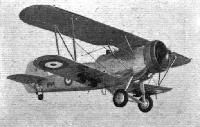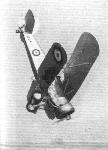
Варианты
- Hawker - Hart - 1928 - Великобритания
- Hawker - Osprey - 1930 - Великобритания
- Hawker - Audax - 1931 - Великобритания
- Hawker - Demon - 1932 - Великобритания
- Hawker - Hardy - 1934 - Великобритания
- Hawker - Hind - 1934 - Великобритания
- Hawker - PV.4 - 1934 - Великобритания
- Hawker - Hartbees - 1935 - Великобритания
- Hawker - Hector - 1936 - Великобритания
Flight, June 1935
NEW and EXPERIMENTAL TYPES at HENDON
Hawker P.V.4: As the letters indicate, this machine has been designed as a "private venture," that is to say, it was not primarily produced to comply rigidly with any Air Ministry specification, although it does in fact meet all the requirements of the G.4/31 specification. In addition, however, this particular machine has been designed with specially high load factors, in order to make it strong enough to be used for dive-bombing. It will be obvious that an almost vertical dive from a great height, followed by a flattening out, imposes severe stresses on an aeroplane. These stresses the Hawker P.V.4 has been designed to withstand. In spite of this, the ratio of bare weight to gross weight is remarkably high, the machine carrying 93 per cent, of its own weight as disposable load. The span is 40ft. and the gross weight 6,650 lb.
Описание:
- Flight, June 1935
NEW and EXPERIMENTAL TYPES at HENDON - Flight, August 1936
A BRITISH DIVE BOMBER
Фотографии
-
Flight 1935-06 / Flight
The Hawker "P.V.4" General Purpose and Dive Bomber aeroplane. The engine is a 700 h.p. Bristol "Pegasus."
-
Flight 1936-04 / Flight Advertisements
THE HAWKER "P.V.4" DIVE BOMBER fitted with the "Bristol" Pegasus X engine is a general-purpose machine of high performance, designed with particular reference to dive bombing requirements. The Pegasus X is a medium supercharged engine which develops 920 B.H.P. for take-off and 870 B.H.P. at 5,750 feet and maximum R.P.M.
-
Flight 1936-08 / Flight
The general layout of the Hawker P.V.4 may be gathered from this view. The resemblance to previous Hawker two-seaters is pronounced.
-
Flight 1935-06 / Flight
THE BOMB-THROWER: It is now possible to disclose the nature of this new "Pegasus"-engined Hawker machine, which was first illustrated in Flight last February. Although a general-purpose type, it has been specially designed for dive bombing, and for this work is claimed to be superior to any foreign design. Its designation is P.V.4, the letters, of course, signifying "private venture," i.e., not built to any particular Air Ministry specification.
-
Flight 1936-08 / Flight
A high-altitude test flight with full military load by Mr. P. W. S. Bulman on the Hawker P.V.4 general-purpose dive bomber biplane.
-
Flight 1935-10 / Flight
The Hawker P.V.4 biplane (Pegasus X) is a recent type in the design of which dive bombing has been a primary consideration.
-
Aeroplane Monthly 1984-07 / A.Lumsden, T.Heffernan - Probe Probare (5)
The Hawker P.V.4 dive bomber was the largest of the Hart family. Though it behaved faultlessly, the competition for the Spec. G.4/31 was won by the Vickers Wellesley.
- Фотографии






